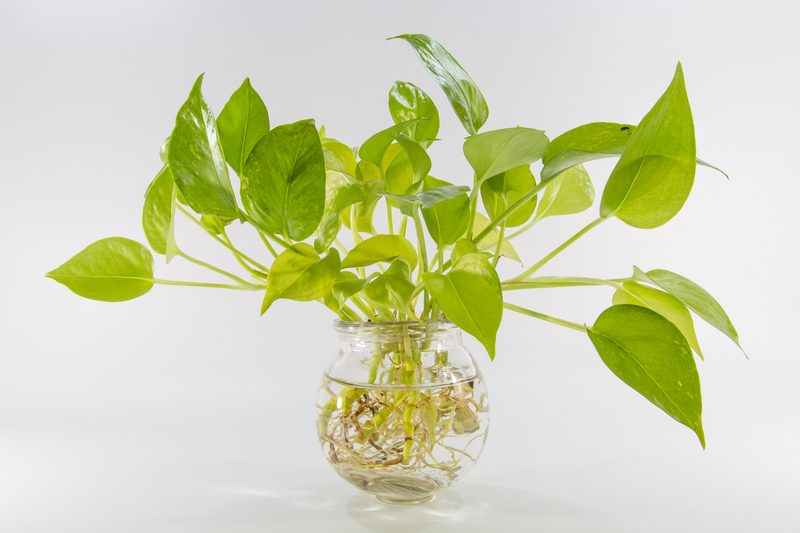Unveiling the Power of Gardening to Fight Climate Change
Posted on 31/05/2025
Unveiling the Power of Gardening to Fight Climate Change
The Surprising Role of Gardens in Combating Climate Change
Climate change stands as one of the most urgent challenges of our time, threatening ecosystems and undermining the stability of human societies. While international agreements and renewable energy innovations dominate headlines, an increasingly powerful -- yet often overlooked -- weapon lies just outside our homes: gardening to fight climate change. This comprehensive guide explores how gardens and mindful gardening practices can make a substantial difference in reducing greenhouse gases, supporting biodiversity, and even fostering community resilience against the climate crisis.

Understanding Climate Change: A Brief Overview
Before delving into the mechanics of gardening for the environment, it's crucial to grasp the basics of climate change:
- Greenhouse Gases (GHGs): Activities like fossil fuel burning, deforestation, and industrial farming release carbon dioxide (CO2), methane, and nitrous oxide into the atmosphere, causing global warming.
- Biodiversity Loss: Climate change disrupts ecosystems, leading to the extinction of plant and animal species.
- Extreme Weather: Increased frequency and intensity of droughts, hurricanes, floods, and heat waves.
While individual actions might seem small compared to these global forces, gardening for climate change mitigation leverages a collective impact that is both tangible and transformative.
How Gardening Helps the Planet: The Science Explained
1. Carbon Sequestration: Turning Gardens into Carbon Sinks
One of the most direct impacts of home gardening on the climate is carbon sequestration. Plants absorb CO2 from the atmosphere and store it in their tissues, roots, and surrounding soil. This natural process can help offset emissions and slow global warming.
- Trees and Shrubs: Woody plants have the capacity to lock away carbon for years, making them ideal for climate-friendly gardening projects.
- Healthy Soil: The richer and more organic matter in your soil, the greater its ability to hold carbon. Practices like composting and mulching boost soil carbon content.
2. Enhancing Urban Biodiversity and Resilience
Urban landscapes are often biodiversity deserts due to lawns and exotic plantings. By cultivating native species and pollinator gardens, gardeners can provide crucial habitat -- supporting wildlife that contributes to robust, resilient ecosystems.
- Pollinator Gardens: Attracting bees, butterflies, and birds supports local food chains and increases plant pollination rates.
- Native Plants: Indigenous species are adapted to local climates and require less water and fertilizer, making them ideal for environmentally conscious gardening.
3. Reducing Urban Heat Island Effects
Cities tend to be hotter than surrounding areas due to concrete and asphalt absorbing and re-emitting the sun's energy. Gardens cool the air by providing shade and releasing water vapor through transpiration.
- Green Roofs/Vertical Gardens: Utilizing spaces like rooftops and walls for greenery reduces building cooling costs and mitigates heat buildup.
- Trees for Shade: Strategically placed trees can lower surface temperatures and reduce air-conditioning needs, further decreasing greenhouse gas emissions.
4. Promoting Sustainable Food Systems
The modern food supply chain is energy-intensive and emission-heavy, due to long-distance transportation, refrigeration, and packaging. Climate-smart gardening allows people to grow some of their own food, reducing reliance on store-bought produce.
- Edible Gardens: Growing vegetables and fruits at home eliminates "food miles" and the associated emissions.
- Composting: Composting kitchen scraps reduces landfill waste and methane emissions, producing natural fertilizer for gardens.
Key Practices for Gardening Against Climate Change
How can you harness the power of gardening for climate change action? These proven techniques and approaches will maximize your garden's environmental impact:
1. Prioritize Perennials and Trees
Perennials and trees draw down atmospheric carbon for decades and support local wildlife with food and shelter. Their extensive root systems also help stabilize soil, reducing risk of erosion.
2. Nurture Soil Health
- Apply Compost: Composting increases soil nitrogen and carbon stores, while reducing dependence on synthetic fertilizers.
- Avoid Tilling: Minimal soil disturbance protects underground carbon stores and promotes beneficial microbial activity.
- Mulch Heavily: Organic mulches conserve water, suppress weeds, and decompose into carbon-rich humus.
3. Water Wisely
- Rain Gardens: Capture stormwater runoff and filter pollutants, replenishing groundwater tables naturally.
- Drip Irrigation: Reduces water use and prevents evaporation compared to sprinklers.
4. Choose Climate-Resilient and Native Plants
Native and drought-tolerant plants are key for sustainable gardening. They require fewer resources and adapt better to local weather extremes, strengthening your garden against climate volatility.
- Resource Efficiency: Less water and fertilizer are needed.
- Wildlife Support: Native plants host insects and pollinators unique to your region.
5. Reduce Use of Synthetic Chemicals
Artificial pesticides and fertilizers are typically fossil-fuel derived and harmful to beneficial soil microbes. Instead, adopt organic alternatives and integrated pest management practices.
6. Encourage Biodiversity Through Diversity
- Plant Variety: The greater the diversity of species in your garden, the more resilient your ecosystem becomes.
- Layered Planting: Incorporate groundcovers, shrubs, and trees to mimic natural ecosystems' multi-level structure.
Gardening Initiatives Making a Real-World Impact
Community Gardens
Community gardening projects in cities around the globe bring people together to transform vacant lots or public spaces into productive green oases. These gardens:
- Provide local fresh produce to underserved neighborhoods
- Educate communities on sustainable practices
- Act as vital green lungs, absorbing carbon and filtering pollution
Cities like Detroit, New York, and Toronto have pioneered urban gardening as a strategy for climate resilience and social well-being.
Reforestation and Restoration Gardening
Many conservation groups run reforestation and habitat restoration initiatives, encouraging citizens to plant trees and native species to revive degraded landscapes. These projects have proven to:
- Sequester huge amounts of carbon over time
- Restore wildlife corridors
- Stabilize local climates and weather patterns
The Personal and Social Benefits of Eco-Conscious Gardening
While gardening empowers us to fight climate change, it also offers a multitude of additional rewards:
- Mental and Physical Health: Studies show contact with nature relieves stress and promotes exercise.
- Food Security: Home and community gardens can buffer against market disruptions and inflation.
- Social Connections: Group gardening builds local networks and enhances collective action for environmental causes.
How to Get Started: A Beginner's Guide to Climate-Friendly Gardening
- Assess Your Space: Observe sunlight, soil conditions, and potential rainwater collection areas.
- Research Native and Perennial Species: Consult local extension offices or botanical gardens for plant lists.
- Compost Organic Waste: Start a compost bin to recycle kitchen scraps and yard waste.
- Minimize Lawn Size: Replace non-native grass with low-maintenance groundcovers, vegetable beds, or wildflower meadows.
- Join Community Efforts: Participate in local gardening clubs or reforestation events.
- Share Knowledge: Teach friends and neighbors about the climate benefits of gardening.
Frequently Asked Questions: Gardening and Climate Change
Can small gardens really make a difference in climate change?
Absolutely! While one garden may seem insignificant, the cumulative effect of millions of urban and rural gardens around the world absorbs significant amounts of carbon and supports invaluable biodiversity. *Every plant counts!*
What are the best plants to grow for climate change mitigation?
Trees such as oaks, maples, and native fruit trees are excellent for carbon capture. Deep-rooted perennials and native wildflowers are also highly effective. Prioritize species adapted to your region's climate for best results.
How does gardening reduce greenhouse gas emissions?
By sequestering carbon in plants and soil, reducing the need for fossil-fuel-powered lawn equipment, and minimizing reliance on industrial agriculture, climate-conscious gardening directly cuts emissions.

The Ripple Effect: Inspiring Broader Change
Gardening for climate action extends beyond individual plots. When people learn to value and nurture green spaces, they become enthusiastic advocates for city greening, renewable infrastructure, and environmental stewardship initiatives. Gardens inspire greater awareness of nature's cycles and a deeper commitment to planetary health.
In summary: gardening is far more than a leisure activity -- it's a crucial tool in our global response to climate change. By reimagining gardens as powerful climate solutions and embracing eco-friendly practices, each of us can be part of a healthier, more resilient future.
Conclusion: Planting Seeds of Hope for a Cooler Tomorrow
As we stand at the crossroads of environmental crisis and opportunity, *the power of gardening to fight climate change* is ready to be unleashed. Whether you garden on a small balcony, in a backyard, or as part of a larger community project, your actions matter. The soil beneath our feet is an immense climate resource, waiting to be cultivated with care and vision.
Start today. Plant a tree, sow seeds, nurture biodiversity, and inspire others -- and together, let's unveil the true power of gardening for climate resilience, carbon capture, and a greener, cooler planet for generations to come.



